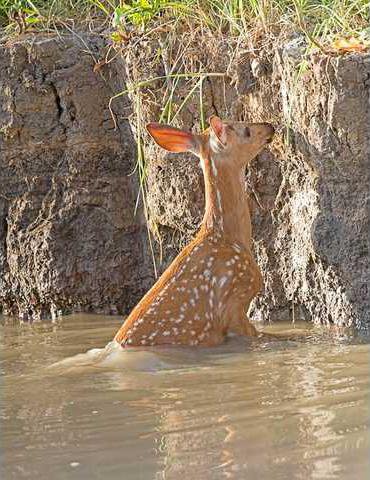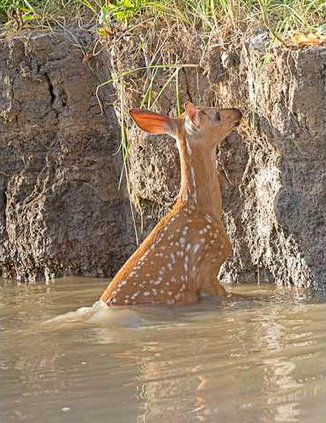I have been watching the Bottoms early in the morning and late in the afternoon. The mid-day heat is oppressive, and most critters and birds try to avoid that uncomfortable part of the day by resting in the shade. The rain last Monday was a very welcome relief.
I watched a white-tailed fawn come down the main canal just east of the headquarters. Kim has worked her magic by removing silt and creating a water-filled area that is steep and about 4-6 ft deep by my best guess. The fawn came to the edge and jumped into the water without hesitation or discomfort and drank. It then worked its way around the edge to a low spot where it exited the water and disappeared into the reeds lining the canal. It was half-grown, and no other deer were present.
That event stimulated me to do a little research on white-tailed deer. I have watched and hunted white-tails and mule deer most of my life. Just like golf balls, white-tailed deer have created huge industries, sold billions of dollars of hunting gear, provided some of the most exhilarating and awful experiences of our lives, and have graced our tables with fabulous tenderloins. They have killed people in vehicle accidents(I lost a very talented doctor-friend to a collision down by Quivira Refuge a few years ago) and consume significant amounts of valuable crops which absolutely hurts some of our farmers.
Breeding deer to produce larger racks is a huge multi-million dollar business. The scoring of antler size by Boone and Crockett and Pope and Young (for archery) is part of the American deer-hunting fabric. Cabelas in Kansas City has a Mule Deer display of the largest Mule Deer on record. For avid deer hunters, visiting that display is a religious experience. It probably should be illegal to sell any antlers– but that is my opinion and is certainly rejected by lots of folks who do make money from selling horns of lots of critters. AND– bragging rights are part of the process.
Photographing and hunting these animals is a lot of fun. Finding a smart, old buck takes a lot of preparation, knowledge of the area, and diligence to go early and stay late. Smart old bucks didn’t get that way by wandering around in open areas for very long. They get side-tracked during the rut which occurs in late October-November. In Kansas, the first two weeks of November seem to be the prime time to hunt the rut. Their vision and sense of smell have created the camouflage and scent management industries. It has also sold a lot of tree stands that have killed and injured a lot of hunters who were careless or forgot their straps.
Herd management is vital to the survival of the process as we know it. When deer invade suburban and urban areas, it causes lots of trouble between the owners of the mutilated foliage, and the people who love the deer. That disagreement will be on-going, I suspect. Hunting has and will continue to be one of the dominant methods of herd management, but it is becoming very difficult to manage the deer in suburban neighborhoods where firearms are properly prohibited. Archery is a viable option in some locations.
White-tailed deer deserve our respect and admiration. They are native to every state except Nevada, Utah, California, Hawaii and Alaska. There are large deer in Canada – Alberta and British Columbia are excellent locations. Texas has the most of any state– over 4 million–and Texas A&M has studied White-tailed deer for many years. A lot of the hunting camps collect teeth for continued evaluation of the maturation and aging process of White-tailed deer.
There are a lot of deer in the Bottoms. There are a lot of BIG deer in the Bottoms. They tend to be nocturnal and stay away from the dike roads as much as possible. If you look at their tracks, you will be amazed where they go in the dark . And then one day a beautiful fawn will ignore you and walk down and get a drink– and make you glad you were there.
Dr. Dan Witt is a retired urologist. Eric Giesing is a biologist.
MARSH MUSINGS
What about white-tailed deer?





